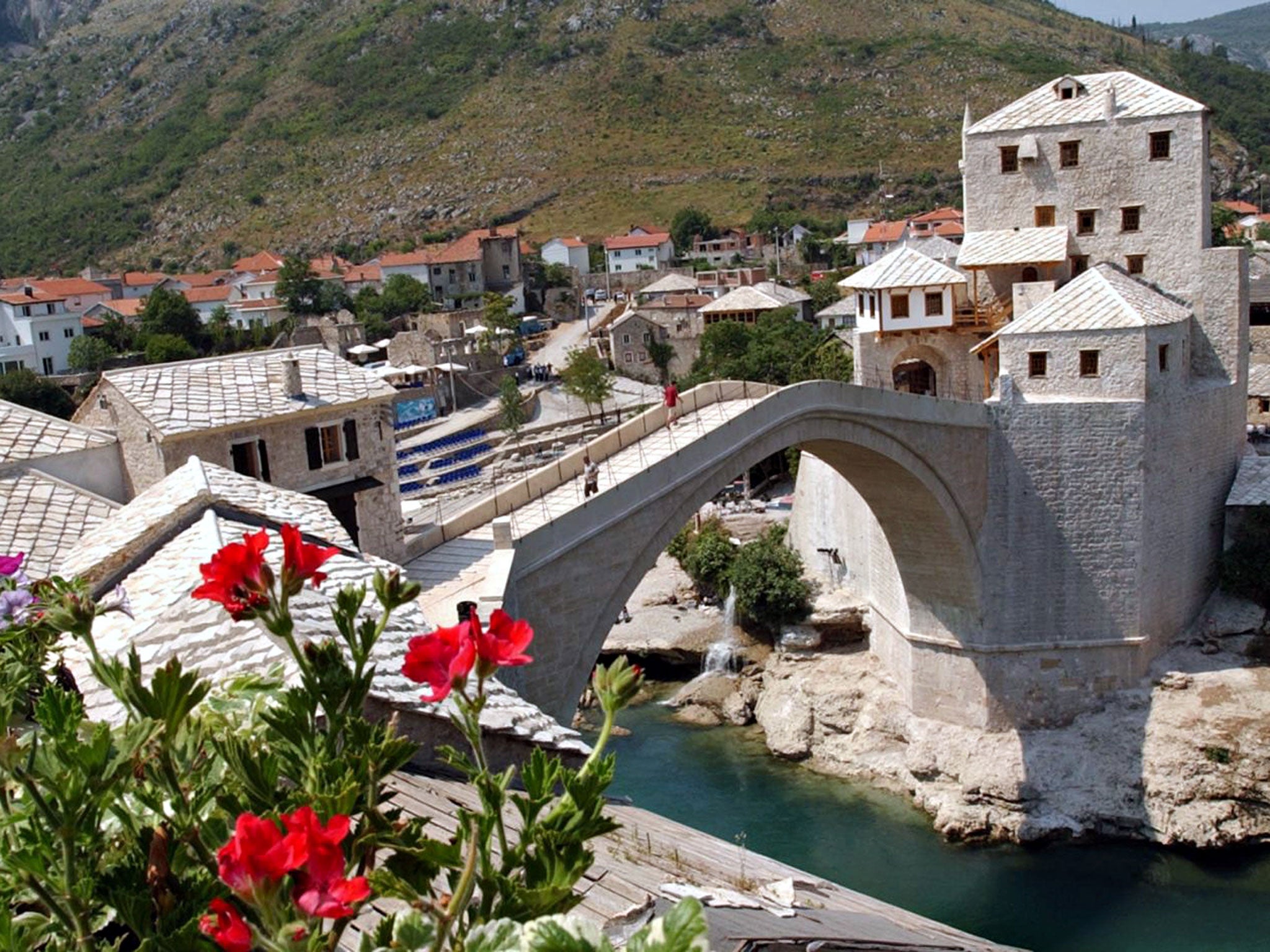The Independent's journalism is supported by our readers. When you purchase through links on our site, we may earn commission.
Herzegovina's bridge over troubled waters
Trail of the unexpected: On the 20th anniversary of its destruction, Henry Wismayer celebrates Mostar's Stari Most – and relishes its restoration

Eyes fixed straight ahead, he spreads his arms with a theatrical slowness: a seasoned performer, playing his crowd. Seventy feet below, the swollen Neretva River rumbles by: narrow, fast-flowing, unknowably shallow at the point directly beneath where he stands. Strung out along the bridge, the gathered spectators crane forward, cameras poised. A bridge diver of Mostar is about to jump.
Rewind 20 years and the atmosphere was very different. In the autumn of 1993, as ethnic hatred ripped the old Yugoslavia apart, the town of Mostar, 80 miles south-west of Sarajevo, was under steady bombardment from Bosnian-Croat forces dug into the surrounding hills. The stone-built structures of the Old Town lay in ruins. At its heart was the famous bridge, Stari Most, a graceful limestone parabola 100 feet across, connecting the predominantly Christian west bank with the Muslim east. Commissioned by Suleiman the Magnificent in the 16th century, it had stood as a potent symbol of inter-religious harmony for 427 years. But now, it cut a ravaged figure. Propped up by a ragged scaffold, bullet-torn sheets were hung along its length, allowing the city's embattled citizens to scurry across shielded from sniper fire.
Today, in the ground floor of the Tara Tower, a former arsenal standing sentinel over the bridge's eastern end, I am watching a television replay – a grainy, flickering recording – of what happened next. On 9 November, the artillery that had been weakening the bridge for days intensified, until one well-aimed shell ruptured the span entirely, and the whole structure went crashing into the water below.
Ducking back outside what is now known as the Old Bridge Museum, it's difficult to reconcile such images with the bustling urban scene that greets me. At the turn of the millennium, an international funding programme set out to restore the war-torn husk to its former glory. The result is a World Heritage Site.
Walking left towards the river, I come to the centrepiece. As Mostar's displaced citizens returned after the war, a cable-strung gantry was erected to allow passage across the Neretva. However, in 2001, work began to resurrect the Ottoman original, its makers employing old techniques to recapitulate its celebrated hump-backed form. In 2004, the ribbon was cut, and the Petrified Moon, as the locals call it, had risen again. Some of the stone I'm treading was dredged up from the waters to which it was consigned on that chill 1993 afternoon.
Arriving on the west bank, I encounter bright-eyed teenagers giving it the soft sell: "Would you like to see our menu?" Several of the restaurants they're peddling have outdoor terraces clinging to the wall of the Neretva gorge, where patrons sip cups of intense Bosnian coffee while pondering the bridge as it changes colour with the day, from brilliant white to brooding bronze.
Not everywhere has been so effectively rehabilitated. Continuing west, bullet holes and mortar scars still pockmark the concrete. Graffiti – some of it disquietingly fresh – screams fascist slogans from the walls. In its role as an emblem of longed-for reconciliation, the bridge, in many ways, has never been more important.
And so, two decades after the original stonework tumbled into the river below, I can return to the bridge and watch local daredevils leap from its apex, an age-old way of proving their mettle. Since dawn, members of the Mostar Diving Club have been petitioning passing tourists to reward their courage with a contribution.
One peels off his shirt, climbs the railing … and drops off the edge. Face contorted, he torpedoes into the frigid water. The crowd looks on anxiously until, just downriver, a tousled head emerges and drifts towards a shelf of rock. He clambers out, waves to accept the applause: a natural survivor, just like the town he calls home.
Travel essentials
Getting there
There are no direct flights from the UK to the capital of Bosnia & Herzegovina, Sarajevo. However, nearby Dubrovnik is served by: British Airways (0844 493 0787; ba.com) and easyJet (0843 104 5000; easyjet.com) from Gatwick, with the latter also flying from Stansted; Jet2 from Manchester; and Monarch (0871 940 5040; flymonarch.com) from Birmingham, Gatwick and Manchester. Split is also an option, again served by easyJet from Gatwick.
Staying there
Muslibegovic House in Mostar (00 387 36 551379; muslibegovichouse.com) has doubles from €75, including breakfast.
More information
Subscribe to Independent Premium to bookmark this article
Want to bookmark your favourite articles and stories to read or reference later? Start your Independent Premium subscription today.

Join our commenting forum
Join thought-provoking conversations, follow other Independent readers and see their replies